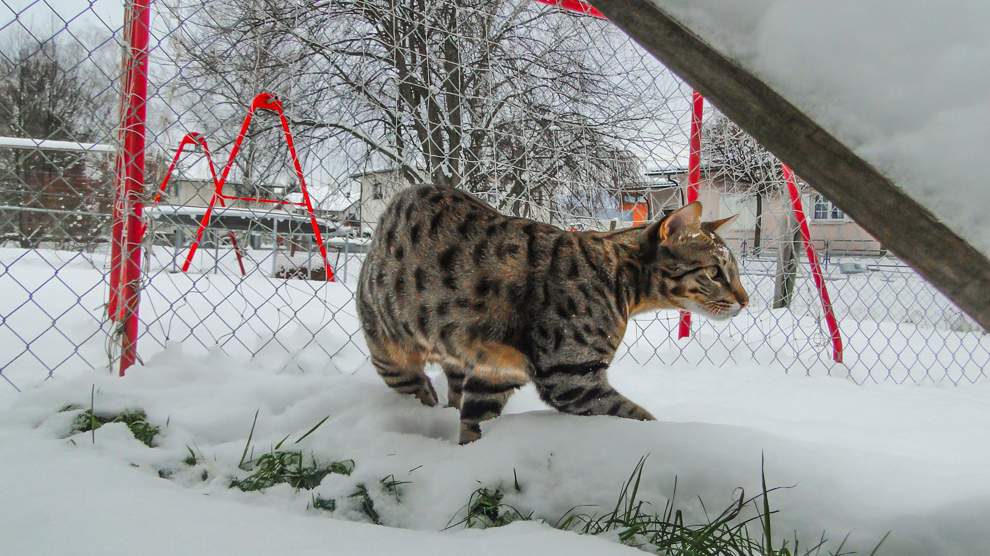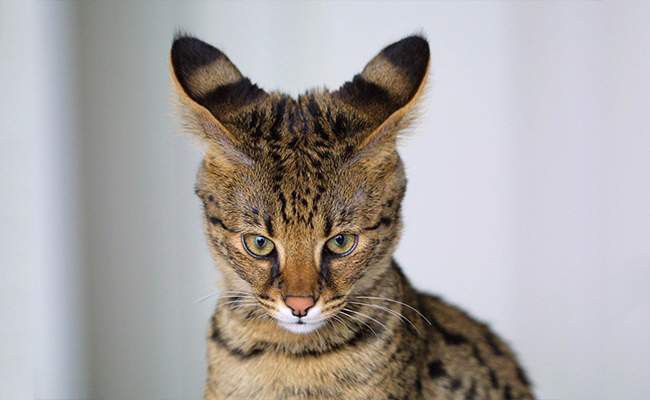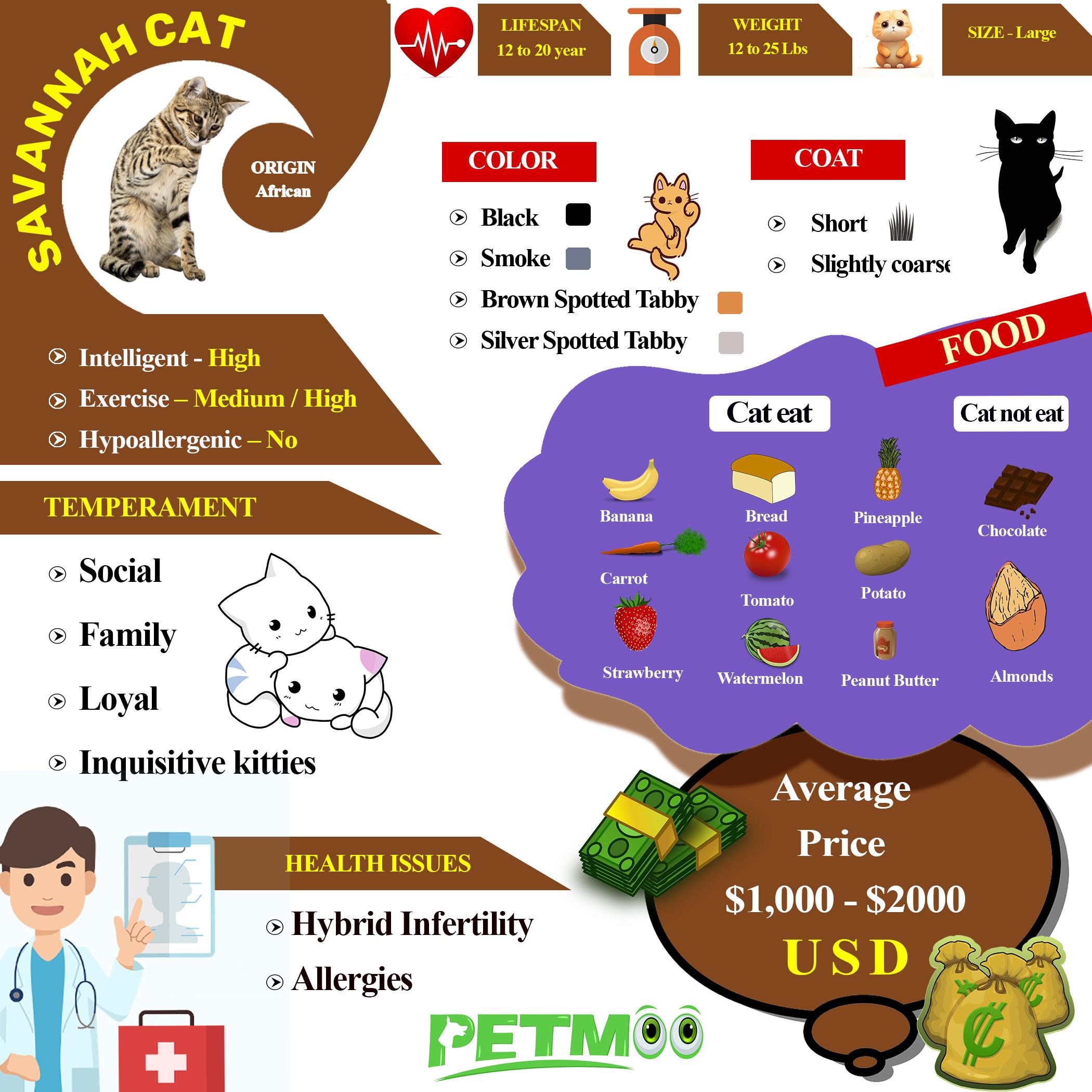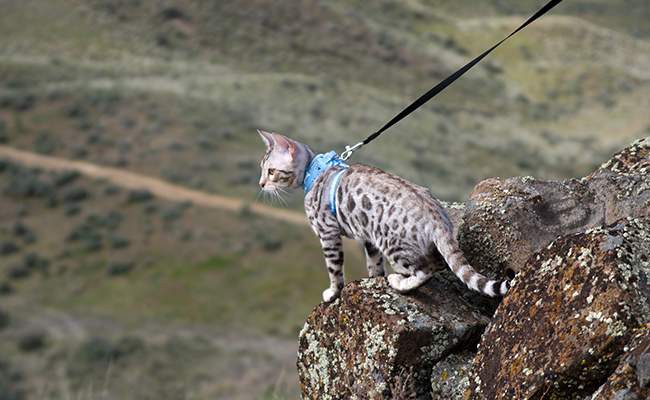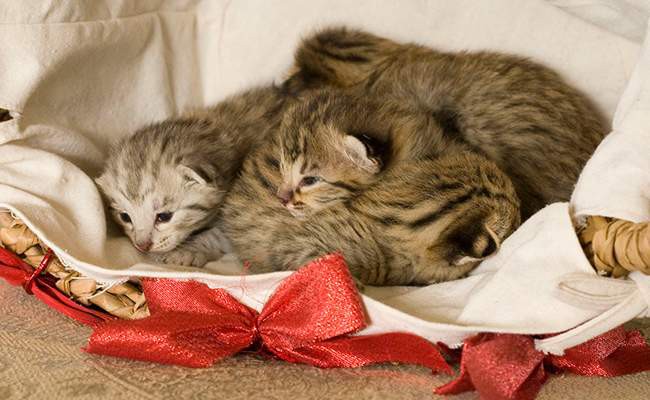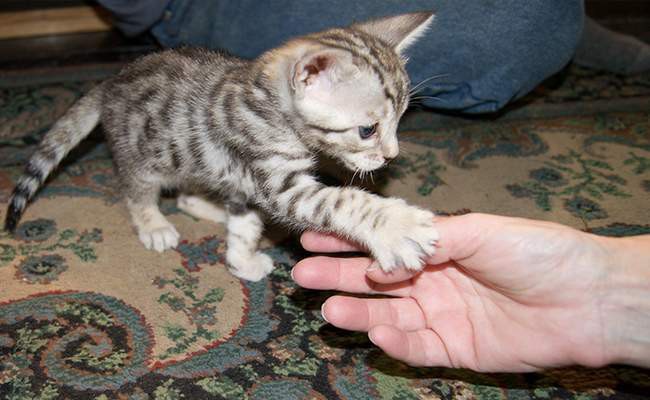- Savannah Cat History
- Savannah Cat Infographic
- Savannah Facts
- Savannah Cat Colors
- Savannah Cat Lifespan
- Savannah Cat Size
- Savannah Kittens
- Savannah Cat Temperament
- Savannah Cat Generations
- Savannah Cat Training
- Savannah Cat Diet
- Savannah Cat Health Problems
- Savannah Cat Legal Requirement
- Savannah Cat Price
- Savannah Cat Adoption
Cat Pregnancy Calculator And Timeline
Savannah cat belongs to the domestic cat breed which has spots all over and it became popular in the 1980s. It came into existence with the picture of grandeur and dignified shape of a wildcat which has its appearance similar to that of a cheetah and may resemble Bengals.
It has quite expressive eyes which is more attractive with sharp tear stains. The coat color of the Savannah cat is also highly vibrant with its solid spots that are absolutely contrasting in its coat shade. It has a huge soar type of legs and lengthy legs.
Yes, they are on Guinness Record!!!! “The World’s Tallest Domestic Cat”- Savannah Cat.
Savannah Cat History
The Savannah cat comes from the ancestral background of African Serval cat. This particular wild feline is active inbreeding within the captivity right from the 1920s however they haven’t been completely domesticated.
The cost of maintenance of the African Serval cats is twice the cost of maintenance of normal cats and they do not go with litter box fully. Without the fear of all the required traits, they have proven to portray in the first generation in absence of the undesired traits.
These desirable qualities and exotic features are the reason most the people who own an African Serval cat get into buying a Savannah Cat. Most of the Savannah Cats have lower than 10% possibility of exotic heritage.
Savannah cat can utilize litter box, go to the veterinarian regularly and has many domestic qualities which aren’t present in Serval cat.
Savannah Facts
It is a breed which has a high resemblance to the traits of its ancestral breed the African Serval. The major objective of this breed is to attain a good shape temperament although it looks like a wild breed.
This makes it a good choice of exotic pet. The light minimal bloodlines make it look similar to the Bengal cats. However, the Bengal cats’ body structure is clearly opposite to that of the Savannah Cats.
Quick facts about Savannah Cats
- Lifespan – 12 to 20 years
- Weight – 12 to 25 pounds
- Exercise – Medium/High
- Hypoallergenic – No
Savannah Cat Eyes
They have medium size eyes with a little-hooded brow. The top part of the eye looks like a boomerang positioned in a perfect angle in such a way that the nook of the eye slants below the line of the nose.
The other half of the ye in the bottom resembles an almond shape. They have slightly deeply positioned eyes, lower over the forehead and are in match with the facial symmetry. You vcan notice tear stain shadings over the eyes and the nose.
You can see all colored eyes and the eye shades are different from coat shade.
Savannah Cat Ears
Ears look similar to the Serval cat. Serval cats are blessed with the largest ears amongst all the felines and largest ears in relation to the size of the head of any cat breed. This makes the ears of Savannah cat biggest and high over the head.
They are spread with an in-depth base. The ears are patterned upright with the rounded tip. The base in the outer part of the ear is below the head than at the top of the eyes but at times set higher.
The inner base of the ear is positioned close to the upper part of the head which makes it perfect to sketch vertical parallel lines from the inner nook of the eyes right to the base inside the eras. Pronounced Ocelli markings over the ears are considered attractive.
Savannah Cas Head
Head is generally wide with an altered wedge with molded countries. The head is lengthier than the width. The anterior posture of the face is seen as distinct in a symmetric triangular pattern.
The nose is lengthier with a little chin. It is better if the head has the “11” mark instead of the “M” mark even though it is not set as the breed standard.
Savannah Cat Pattern
The pattern is usually solid sharp shade spots which are either in the round or oval shape spread all over the body and is not interlinked with one another.
A sequence of stripes that are parallel from behind the head to right above the shoulder blades spread out little above the back. Tiny spots are seen over the legs and foot and also over the face.
The body is covered with thick short hair that has a soft or coarse texture.
Savannah Cat Colors
Savannah cats are generally seen in brown, silver, black and shades of smoke. The more attractive colors are the ones which are similar to the African Serval.
The quite common series of African Serval is the buttery gold shade filled with solid sharp black spots. Gold being s shade of brown color it is perfectly recognized as a brown spotted tabby (BST).
- Brown Spotted Tabby – Aguoti Cat (A-)
- Silver Spotted Tabby – Aguoti Cat (A-) + Inhibitor gene
- Black – Non-Aguoti Cat (AA)
- Smoke – Non-Aguoti Cat (AA) + Inhibitor gene
Savannah Cat Lifespan
Domestic cats have the lifespan of living up to 15 years and on an average, they live up to 10-12 years. Serval Cats are blessed with a lifespan of about 20 years. Savannah cats can live healthy up to 12-20 years which depends on the heritage base of the Serval cat.
It is factual information that those cats which have an intake of balance raw meat combination tend to have a good chance of living longer.
Savannah Cat Size
Size of the Savannah cats is usually pictured big as they look tall, thinly structured and posses lengthy body that the usual domestic cats. There is an illusion of weighing heavier as its body is quite tall.
However the weight of the cat is based on the bloodline of every individual. Weight of the cat is generally around 12-25 pounds.
Savannah Kittens
Bottle fed cats of a specific generation are seen with a good exotic heritage that guarantees the best temperament.
Bottle Feeding:
Feeding with a bottle at minim is about four weeks throughout the daycare. Bottle feeding is a must in the first generation as the breed suffers a bit of prematurity and raised exotic content.
The domestic cat has a pregnancy period of about 63 days and the serval cat’s pregnancy period goes up to 74 days. Due to this fact their high chances of the kittens being born prematurely and it requires special attention after the birth in the early weeks.
This complicated step results in prices shooting high because of the time and skill involved. It is necessary to understand that any kind of cat breed which is not given proper care and socialization will end up in maladjusted social behavior.
Savannah Cat Temperament
The temperament of these cats is highly appreciable when correctly socialized. The feline type to a dog that is suitable for owners who like to keep away from any special canine needs.
Attentively involved in social communication, instant pouting if left alone, being as a kitten-like always. Being quite loyal to all the members of the family and questioning about the strangers around.
They make beautiful relationships which are known for its loyalty, intelligence and eagerness in them. They portray the capacity to understand simple to complicated instructions.
Savannah Cat High Intelligence:
Being highly intelligent along with the inbuilt curiosity nature in them often puts them to behaving mischievously. As they have the traits of sharp intelligence, curiousness and good energy level they have, they are more comfortable with active owners.
Savannah Cat Generations
Generations indicate the total pairings which fell out of the exotic ancestor. Generations play a remarkable role for the breeder as the stud male breed are considered infertile till the F6 or above is pulled out.
The F1 generation is the base of the breed (Serval x domestic). Rests of the generations are a consequent partnering of a savannah male pair to a Savannah female partner.
- F1 Savannah Cat
- F2 Savannah Cat
- F3 Savannah Cat
- F4 Savannah Cat
- F5 Savannah Cat
- F6 Savannah Cat
F1 & F2 generations have quite a little litter one time annually, at the time they even prolong longer time without giving birth. This raises the adoption cost of such generations.
F1 Savannah Cat
- Pairings are highly complicated, quite low fertility, small litters
- Price: $17,000 – $22,000
F2 Savannah Cats
- Pairings are complex, less fertility, small litters
- Price: $6,000 – $10,000
Lower Generations (F3-F6)
- Pairings are normal, average fertility, moderate litters
- Price: $1,200 – $4,000
Savannah Cat Training
Savannah Cat Leash Training
Leash training tried on Savannah cats has mostly reaped positive results. They need leash training with a harness. Walking over a leash along the harness usually requires some patience and training.
Moreover, Savannah cats are highly intelligent which requires the owners to be to take out enough time in giving perfect mental stimulations to the breed.
Savannah Cat Exercise
Exercise is necessary, the energy level ranges from medium to high. Exercise along with mingling among them is the major aspect of a kitten’s transformation into adulthood.
Being exposed to socialization with a positive attitude is the best to expect in this breed.
Savannah Cat Diet
The nutrition need is generally similar to that of a normal domestic cat. They do not demand a raw meat diet but a balanced diet with raw meat is considered a highly nutritional diet.
The diet plan can be worked out at its best in coordination with veterinarian or breeder as it would best suit the number of times a kitten and cat is to be fed for a healthy long life. Freshwater is a must requirement always.
Foods Cats Can Eat:
Pork and Bacon
Foods Cats Must Not Eat:
Savannah Cat Health Problems
Health issues are not very particular to this breed at a given time. Genetic testing is quite important to keep away certain ailments in a long run. Reproduction and breeding are bit complicated and fertility graph is a bit low.
There are hardly 1 to 3 kittens delivered by a cat. The major reason for infertility among this breed is genetics. Also, these cats are very choosy and get along only with those cats with which they have been around since kitten-hood.
Gestation time of the serval is about 10 days lengthier than the domestic breed, which means F1 and F2 are quite rarely delivered. Savannah breed doesn’t need any particular special health supervision.
A visit to the regular veterinarian is good enough for the feline health care of these cats.
Hybrid Infertility
Hybrid infertility refers to a hybrid crossbreed that is unable to reproduce. Joyce Sroufe, the founder of this particular breed kept along all the generations trying to attain fertile males.
However Joyce Sroufe was not successful till the five generations were taken away, her pairings turned outcrosses which ended up in slightly exotic content. Theoretically, this content requires to be 10% or lesser.
As the breed moves further pairing turns to be on a higher content which results in males being taken away still more to retain fertility. If a higher content male is seen fertile they generally seem to have small litters and turn out sterile within a short span of a time period (generally in a year of guaranteed fertility).
Allergies
Allergies do affect the Savannah cats in spite of the breed being lower shedding cat breed. None of the cat breeds is perfectly hypoallergenic and grooming is needed. Individuals affected with allergies seem to react lesser but there is no scientific information which proves on hypoallergenic cat breeds.
Maximum allergy affected people are allergic to the protein present in the cat saliva and not in its hair, so they are prone to the allergy of all felines.
Savannah Cat Legal Requirement
Legal formalities need to be adhered to in certain states of the USA. Savannah cats at times get trapped in the ban bills simple because of the terms meant to restrict the ownership of big exotic pets.
Usually these ban bills get corrected as time passes and after proper guidance is given to the officers. The states which have restriction are as follows:
- Alaska
- Delaware
- Georgia
- Idaho
- Iowa
- New York
- Nebraska
- New Hampshire
- Massachusetts
- Rode Island
- Texas
- Vermont
Savannah Cat Price
The price of the cat is determined based on the confirmation to the standard of the breed, temperament, scarcity, vaccination details, and demand.
When a Savannah cat has the qualities on par with the breed’s standard traits the cat tends to have a high value as a pet and turns worthy for the breeder.
Breeders being TICA registered members has the obligation to issue registration papers, vaccines at the appropriate intervals and take care of the kitten’s un till they reach 10-14 weeks which is expensive.
The normal rearing expense of a registered pedigree kitten turns out in adoption cost over $1200(this applies to all pedigree cat breeds.)
Savannah Cat Adoption
Must Consider things before the adoption of a Savannah Cat
Savannah Rescue has choices of foster homes that are qualified and keeps the saved cats in such locations to assess the cat initially until a perfect permanent home is arranged for them.
The rescue can function along the foster homes for rehabilitation of these cats if required, get them vetted that is vaccinated and spayed or neutered if required and to decide any specific desires or requirement they may have.
There is a tendency to give early preference to foster homes which adopt fostered Savannah breed if it happens to reach their home obviously.
Is a Savannah Cat a right choice for you?
It is a surprising fact that most Savannah cat owners do not get this pet for its exotic looks. Instead, they look out for a pet with combined features which the Savannah cat intends to offer.
Are you looking for the following traits in your cat as a pet, and then Savannah Cat is your right pick.
- High/Average Energy Level
- Not Lap Cats (They would Be Next To You)
- Good Intelligence
- Utilize a Litter-Box
- Rambunctious
- Lovable
- Expressive
- Curious
- Outgoing

